Distinguished Critique: The New Teen Titans (vol. 1) Review
Though perhaps too heavily reliant on parent-centric conflict, New Teen Titans successfully reintroduces a DC superteam to the Bronze Age
—by Nathan on February 6, 2025—
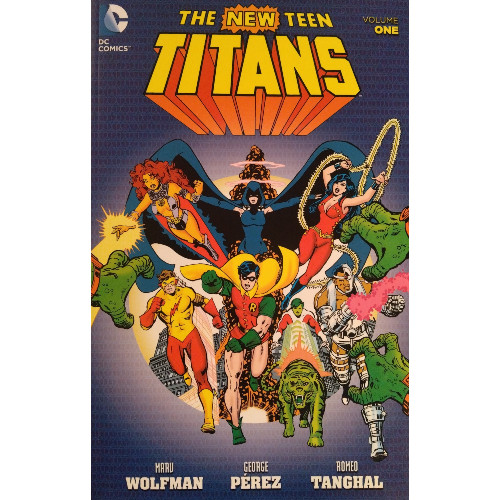
In 1980, as DC was recovering from a financially frustrating "implosion" which occurred at the tail end of the 70s, the comics company was weary of developing new properties. DC dabbled in some smaller narratives, pioneering the "limited series" with 1979's World of Krypton and 1980's Untold Legend of the Batman, but they largely steered clear of introducing brand new longform series. There was too much risk, the powers-that-be decided.
So when Marv Wolfman approached those powers-that-be and asked if he could revitalize a group of young (some may even call them "teens") heroes (some may even call them "titans") whose own book had been canceled two years prior (and not because of low sales but because the series had just been so darn bad), his superiors were understandably wary. But Wolfman wouldn't take no for an answer, and paired alongside editor Len Wein and artist George Perez (whom Wolfman had poached from Marvel immediately after Perez illustrated an Avengers anniversary issue the word "controversial" doesn't even begin to appropriately cover), he pitched the series again. He wanted to do Teen Titans…and he wanted to do them right.
DC relented, and despite some post-inaugural issue sales concerns, the New Teen Titans became a hit…and stayed that way for quite some time. It seems Wolfman and Perez, no strangers to the Jim Shooter-led Marvel methods of madness, had brought over the same fantastic characterization, soap opera-style drama, and bombastic superheroics that carried one of the best-selling titles from the House of Ideas: the X-Men. The same year Chris Claremont, Dave Cockrum, and John Byrne deconstructed the phiery, phlashy Phoenix, Wolfman and Perez constructed a new team…but fans would have to wait for the pair to reach their own "female ally turns enemy" story. First, the Titans needed some rebuilding.
The New Teen Titans (vol. 1)
Writers: Marv Wolfman, George Perez
Pencilers: George Perez, Curt Swan
Inkers: Dick Giordano, Romeo Tanghal, Frank Chiaramonte, Pablo Marcos
Colorists: Adrienne Roy, John Drake
Letterers: Ben Oda, John Costanza
Issues: DC Comics Presents #26, New Teen Titans #1-8
Publication Dates: October 1980-June 1981
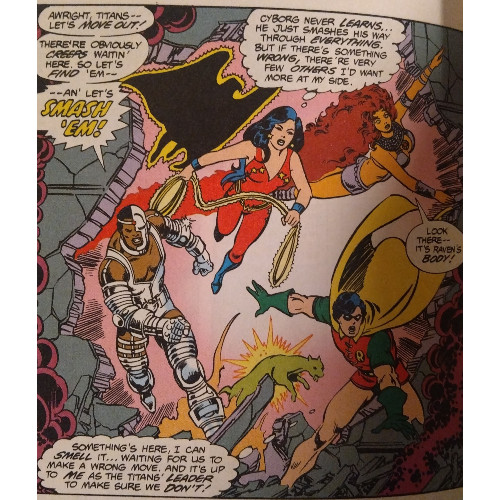
For primarily educational reasons (but with a dash of personal gratification), I spent a portion of last summer diving into comics from 1980…not necessarily the 80s overall (though I do love me some narratives from that era in general), but from that singular year which began the decade of disco. It's why I examined the John Byrne/Jim Aparo-illustrated condensation of Batman's origin as well as Art Spiegelman's moving depiction of the Holocaust in Maus. Wolfman and Perez's New Teen Titans fell into that category, sitting right alongside Maus, "The Dark Phoenix Saga" and Frank Miller's first foray into Hell's Kitchen under the umbrella of "comics from 1980 you would do well to pick up and read."
Wolfman and Perez were a few years away from dismantling the DC multiverse (and Perez a ways away from his contribution in restructuring that universe as well as briefly wreaking carnage over at Marvel as well), but the two find remarkable synergy in developing these young characters, not only reintroducing readers to "old" Titans such as Robin, Kid Flash, and Wonder Girl but introducing new characters such as Cyborg, Starfire, and Raven. Growing up, I wasn't a stalwart Teen Titans viewer, but I remember enough of the early 2000s cartoon to understand a bit of (most of) the characters utilized in these issues. I shouldn't have been surprised to find that Wolfman and Perez's versions were, in ways, far cries from the kid-friendly cartoon versions, but I found the differences compelling.
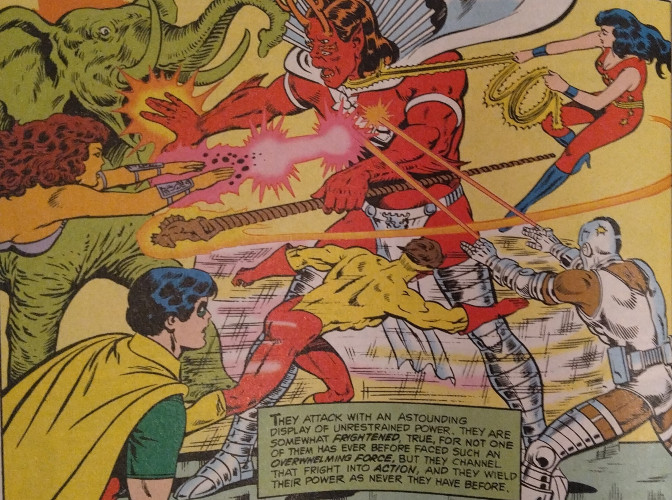
In an introduction, Wolfman outlines several major characteristics of his protagonists, tethering their struggles largely to their upbringing or parents. Starfire, an alien princess handed over by her father to intergalactic invaders, maintains the same "fish out of water" ignorance as her cartoon counterpart but takes near gleeful joy in fighting and demolishing adversaries. I don't remember Vic Stone's Cyborg undergoing an existential crisis over his half-human/half-cyborg body in the animated series; here, we have a Cyborg who feels conflicted over not just his new body but also the man he blames for putting them there: his father, Silas Stone, who was only trying to save his son's life after a laboratory accident. The child of a demon father, Raven is presented as less goth-like and more purely enigmatic, stringing along at least one Teen Titan as she pulls the team together and causing at least one crisis of confidence which threatens to tear the team asunder. Her intentions seem noble, but her actions feel otherwise–can the Titan trust her?
These young heroes constantly feel they're in a place where they need to prove themselves. Robin uses the team as an opportunity to grow out from under the long, leathery wing of the Batman, planting seeds which will sprout in the form of his new identity as Nightwing. Raven physically fights her father to show she will not end up under his thumb. Kid Flash (years before Wally West assumed the mantle of his uncle) wrestles with his own motivations for belonging on the team, feeling the least convinced that his future lies in superhero shenanigans. Each hero is at an important transitory time in their lives, and Wolfman and Perez utilize those common tropes of adolescence–framing one's identity, struggling with authority, developing important relationships, determining a future–to draw in their audience, making their characters relatable to readers.
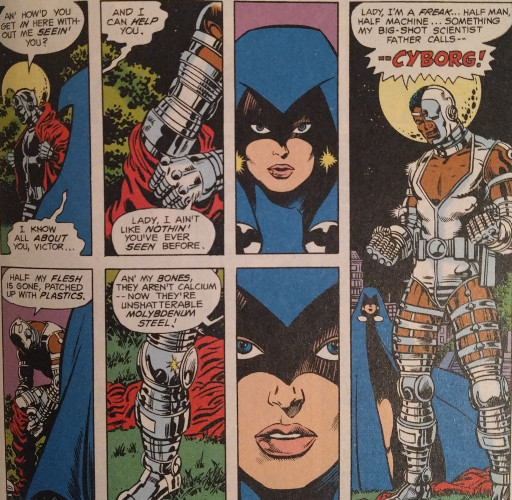
A main plot congeals a little ways into the book, with the first few issues allowing the Titans to find their footing as a group, shape thematic dynamics, and establish working relationships. A few tussles with the Fearsome Five give readers a couple doses of colorful superhero smackdowns while Wolfman and Perez craft a somewhat larger story arc. This arc proves to be a wonderfully told "baptism of fire" for the Titans to endure which, with appearances from the Justice League, gives the group the opportunity to separate themselves from the authority figures in their lives. They aren't sidekicks anymore. They aren't kids. They aren't taking orders from Batman and Wonder Woman when they've got their paths to follow. The symbolism is a little blunt, especially when Robin tells the League off after a pitched battle between the two groups due to some villainous manipulation. But the point is made clear, and if readers doubt it, they're easily assured when the Titans battle Trigon on several occasions, working through their own limitations to do together what they'd never be able to accomplish separately.
Certainly, the X-Men parallels exist. Claremont, Cockrum, and Byrne, particularly during the mid-to-late 70s/early 80s, stuffed Uncanny X-Men full of compelling characters that worked out their problems individually while contributing to an ever-expanding community. The same formula exists here, though I'd argue Claremont introduced more variety with his characters. The "variation on a theme" fuels Teen Titans, particularly that parent/child dynamic, and though it forms a baseline for the series, we're not given a myriad of developments or angles for our heroes to tackle emotionally. It all falls along the "the kids are growing up" theme, which works well for the series at this point. By the time Claremont began writing X-Men, most of the characters were beyond adolescence; they required new personal challenges to tackle. The heroes Wolfman and Perez bring together are young adults and thus need this specific change to separate themselves from their mentors and parents.
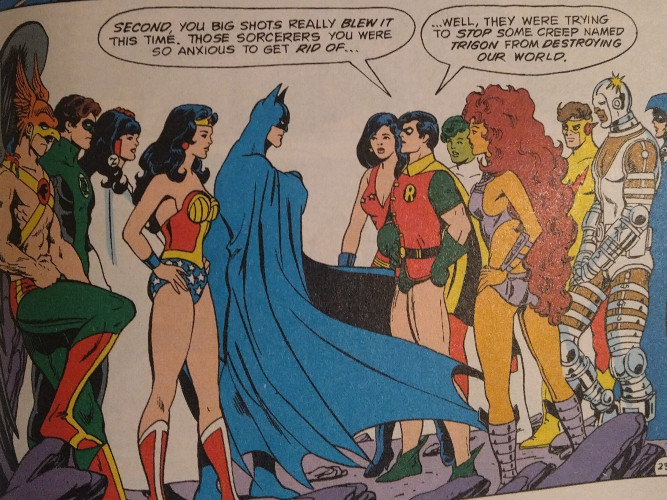
I don't know how Wolfman and Perez diversified their heroes as the series continued, but the fact Teen Titans remained a high seller (rivaling, but never eclipsing, the sales of Uncanny X-Men) and that the pair remained on the book as long as they did seems a testament to their skills individually as well as in cooperation. Wolfman's prose offers a poetic litheness to scripts which could otherwise feel flat, toeing the same line as Claremont by blending the Stan Lee verbosity with the rhythms of a more seasoned storyteller, Don McGregor for example. Perez's work is perhaps not as experimental as his contributions to Wonder Woman or his work on Crisis on Infinite Earths, but his panels convey narrative coherence. He's at his best when he slows down on moments, closes in on faces, or guides some wordless panels, offering singular moments where you can zoom in on the art and not be bothered by words.
Subplotting–another tactic which feels deliberately lifted from the Claremont School of Writing Comics–worms its way into these narratives, in a rather refreshing manner. Cutaways reveal some goings-on the Titans aren't yet aware of as the volume closes out, but these do not hamper the narrative flow or feel forced into place the way a lesser writer would fail to convey–you never feel wrenched away from the story in progress by a showy text box declaring "And now we momentarily leave our heroes to espy some nefarious ne'er-do-ll in yonder dank alleyway, etc. etc." We're even given–can it be?–resolution to one of the first subplots Wolfman and Perez work in, a shadowy secret lurking on the fringes of a few issues before a satisfying conclusion is offered. Which is great for anyone who wants this volume to give them a fuller taste of the Titans.
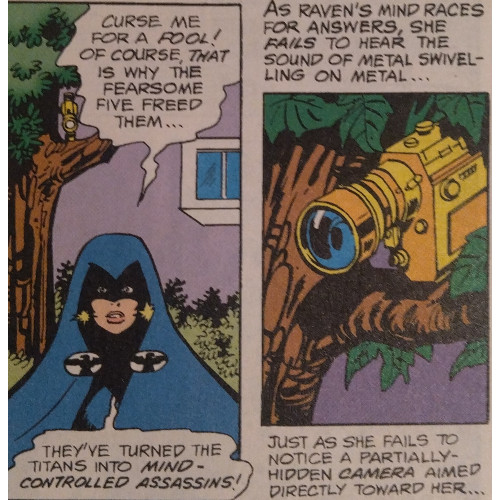
Wolfman wanted to write some totally tubular teens, my dude, and they're so bad, they keep me from wanting to gag on a spoon and–
Uh…my generation never spoke like when we were teenagers…let's go again.
So, yeah, Wolfman creates some highly believable characters, with touches of humanity and personality set to rival (yet not quite eclipse) Claremont's X-Men (I'm a Marvel fan; I can only give a DC book so much credit). There's a nicely developed foundation here, our characters born atop tragedies caused (sometimes unwittingly) by their parents, the team born atop a mission to prove themselves to the Big Names. We don't need no Batman here, aight? Wolfman and Perez largely succeed in this volume, introducing us to the new kids on the block, kids who aren't gonna be pushed around anymore. That's why they call themselves "Titans," so you don't confuse them for the gods they pal around with. They're not the big leagues, not yet anyway. But across these issues, they prove that, one day, they'll grow to match their heroes. And, yes, some of them will eventually replace their role models (lookin' at you, Wally West), but others (lookin' at you, Dick Grayson) really will use this chance to become something different, mold themselves in the way they want to rather than the way others may place upon them.